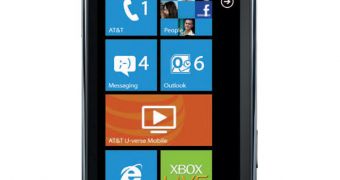Windows Phone 7, the latest flavor of Microsoft's mobile operating system, comes to the market with a series of rather interesting features when it comes to the possibility to expand the available storage space on a device running under the platform. As reported ever since the operating system was still in the development phase, Windows Phone 7 does not come to the market with support for interchangeable microSD memory cards.
According to wireless carrier AT&T, the Windows Phone 7 devices it put on sale last week come with support for expandable storage via microSD cards, but the carrier does not advise users to add a new card into the mix.
Of course, microSD cards can be put inside Windows Phone 7 devices, but only special cards, which are compatible with the operating system. Otherwise, it appears, the cards are rendered unusable.
“Windows Phone 7 does not support swapping microSD cards in and out. SD cards inserted into a Windows Phone 7 device are integrated into the device's file system and are intended to be a permanent modification to the device,” Microsoft stated on the matter, according to seattlepi.com.
“Once an SD card has been integrated into a Windows Phone 7 device's file system, it will no longer be readable or writable on any other device. This behavior is by design and is intended to ensure a consistently high-quality and secure end-user experience.”
Users are advised to wait until “Certified for Windows Phone 7” microSD memory cards are made available for purchase on the market, otherwise the device might become unstable, or all data on the cards erased.
While there are issues with adding a microSD memory card on a Windows Phone 7 device, it appears that the operating system supports a USB Storage mode.
Basically, this means that one would be able to use a Windows Phone 7 mobile phone as a USB drive, which would eliminate the need of using the Zune software for copying data on the handset.
Things are not as simple as they might appear, it seems, but the enabling of this mass storage mode is only a few clicks away in the end, as all the modifications required for enabling this need to be done on the desktop PC.
According to a recent article on mobiletechworld, the process involves the following:
- Open Windows Registry Editor by typing regedit in your start menu - Go to HKEY_LOCAL_MACHINE\SYSTEM\ - Then go to HKEY_LOCAL_MACHINE\SYSTEM\CurrentControlSet\Enum\USB (and not the other ControlSet01 or 02 if you have them) and then search for ZuneDriver As soon as this was done, one would have to edit the following entries:
- Change ShowInShell from 0 to 1 <- this enable Windows Explorer to show the device when pluged in - Change PortableDeviceNameSpaceExcludeFromShell from 1 to 0 - Change EnableLegacySupport from 0 to 1 <- this enables Windows Explorer to detect the device
As soon as this was made, plugging in the Windows Phone 7 device would immediately show it in Explorer. In order to modify the files on the handset, one would have to close the Zune desktop app.

 14 DAY TRIAL //
14 DAY TRIAL //